bonnet Peugeot Bipper 2008 Owner's Manual
[x] Cancel search | Manufacturer: PEUGEOT, Model Year: 2008, Model line: Bipper, Model: Peugeot Bipper 2008Pages: 131, PDF Size: 1.44 MB
Page 5 of 131
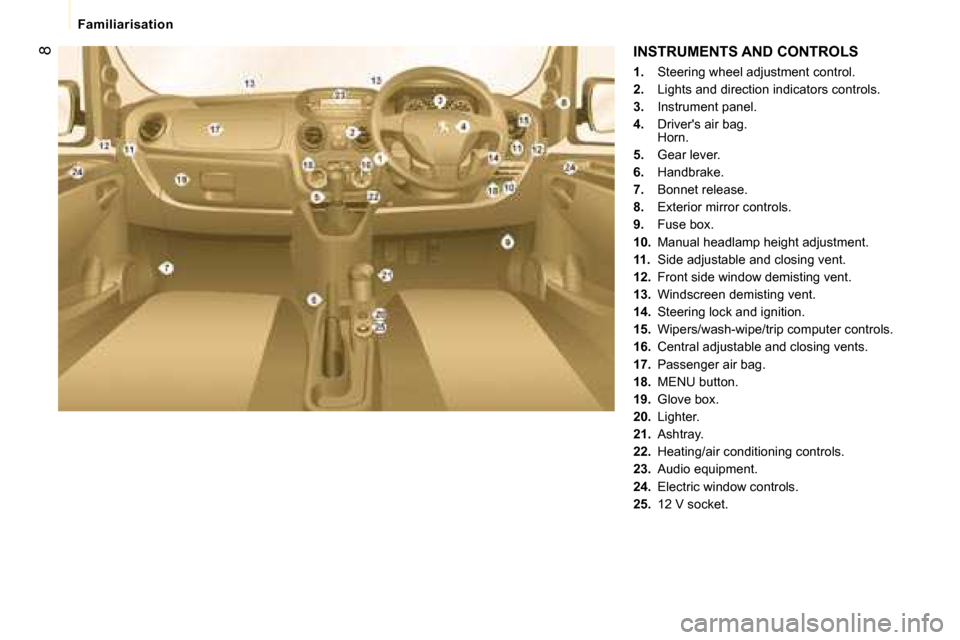
8
Familiarisation
INSTRUMENTS AND CONTROLS
1. Steering wheel adjustment control.
2. Lights and direction indicators controls.
3. Instrument panel.
4. Driver's air bag.
Horn.
5. Gear lever.
6. Handbrake.
7. Bonnet release.
8. Exterior mirror controls.
9. Fuse box.
10. Manual headlamp height adjustment.
11. Side adjustable and closing vent.
12. Front side window demisting vent.
13. Windscreen demisting vent.
14. Steering lock and ignition.
15. Wipers/wash-wipe/trip computer controls.
16. Central adjustable and closing vents.
17. Passenger air bag.
18. MENU button.
19. Glove box.
20. Lighter.
21. Ashtray.
22. Heating/air conditioning controls.
23. Audio equipment.
24. Electric window controls.
25. 12 V socket.
Page 27 of 131
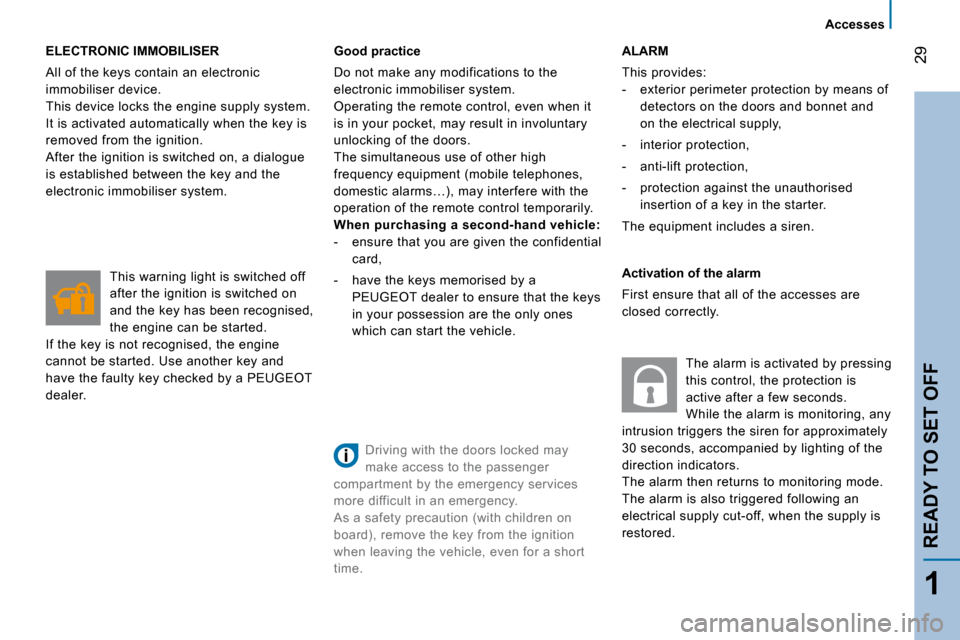
29
1
READY TO SET OFF
Accesses
ELECTRONIC IMMOBILISER
All of the keys contain an electronic
immobiliser device.
This device locks the engine supply system.
It is activated automatically when the key is
removed from the ignition.
After the ignition is switched on, a dialogue
is established between the key and the
electronic immobiliser system. This warning light is switched off
after the ignition is switched on
and the key has been recognised,
the engine can be started.
If the key is not recognised, the engine
cannot be started. Use another key and
have the faulty key checked by a PEUGEOT
dealer .
Good practice
Do not make any modifications to the
electronic immobiliser system.
Operating the remote control, even when it
is in your pocket, may result in involuntary
unlocking of the doors.
The simultaneous use of other high
frequency equipment (mobile telephones,
domestic alarms…), may interfere with the
operation of the remote control temporarily.
When purchasing a second-hand vehicle:
- ensure that you are given the confidential card,
- have the keys memorised by a PEUGEOT dealer to ensure that the keys
in your possession are the only ones
which can start the vehicle.
Driving with the doors locked may
make access to the passenger
compartment by the emergency services
more difficult in an emergency.
As a safety precaution (with children on
board), remove the key from the ignition
when leaving the vehicle, even for a short
time.
ALARM
This provides:
- exterior perimeter protection by means of detectors on the doors and bonnet and
on the electrical supply,
- interior protection,
- anti-lift protection,
- protection against the unauthorised insertion of a key in the starter.
The equipment includes a siren.
Activation of the alarm
First ensure that all of the accesses are
closed correctly.
The alarm is activated by pressing
this control, the protection is
active after a few seconds.
While the alarm is monitoring, any
intrusion triggers the siren for approximately
30 seconds, accompanied by lighting of the
direction indicators.
The alarm then returns to monitoring mode.
The alarm is also triggered following an
electrical supply cut-off, when the supply is
restored.
Page 30 of 131
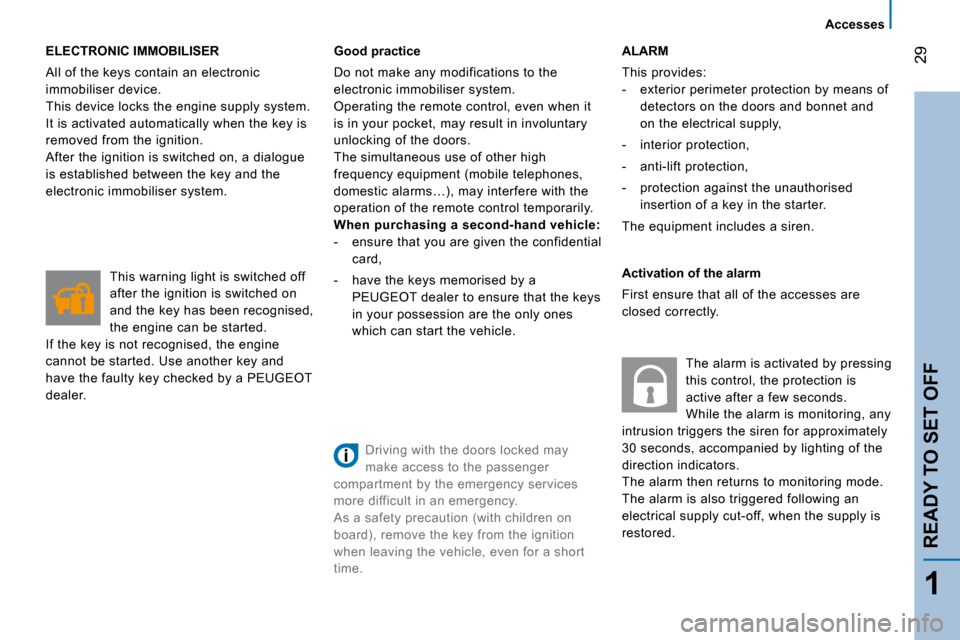
29
1
READY TO SET OFF
Accesses
ELECTRONIC IMMOBILISER
All of the keys contain an electronic
immobiliser device.
This device locks the engine supply system.
It is activated automatically when the key is
removed from the ignition.
After the ignition is switched on, a dialogue
is established between the key and the
electronic immobiliser system. This warning light is switched off
after the ignition is switched on
and the key has been recognised,
the engine can be started.
If the key is not recognised, the engine
cannot be started. Use another key and
have the faulty key checked by a PEUGEOT
dealer .
Good practice
Do not make any modifications to the
electronic immobiliser system.
Operating the remote control, even when it
is in your pocket, may result in involuntary
unlocking of the doors.
The simultaneous use of other high
frequency equipment (mobile telephones,
domestic alarms…), may interfere with the
operation of the remote control temporarily.
When purchasing a second-hand vehicle:
- ensure that you are given the confidential card,
- have the keys memorised by a PEUGEOT dealer to ensure that the keys
in your possession are the only ones
which can start the vehicle.
Driving with the doors locked may
make access to the passenger
compartment by the emergency services
more difficult in an emergency.
As a safety precaution (with children on
board), remove the key from the ignition
when leaving the vehicle, even for a short
time.
ALARM
This provides:
- exterior perimeter protection by means of detectors on the doors and bonnet and
on the electrical supply,
- interior protection,
- anti-lift protection,
- protection against the unauthorised insertion of a key in the starter.
The equipment includes a siren.
Activation of the alarm
First ensure that all of the accesses are
closed correctly.
The alarm is activated by pressing
this control, the protection is
active after a few seconds.
While the alarm is monitoring, any
intrusion triggers the siren for approximately
30 seconds, accompanied by lighting of the
direction indicators.
The alarm then returns to monitoring mode.
The alarm is also triggered following an
electrical supply cut-off, when the supply is
restored.
Page 32 of 131
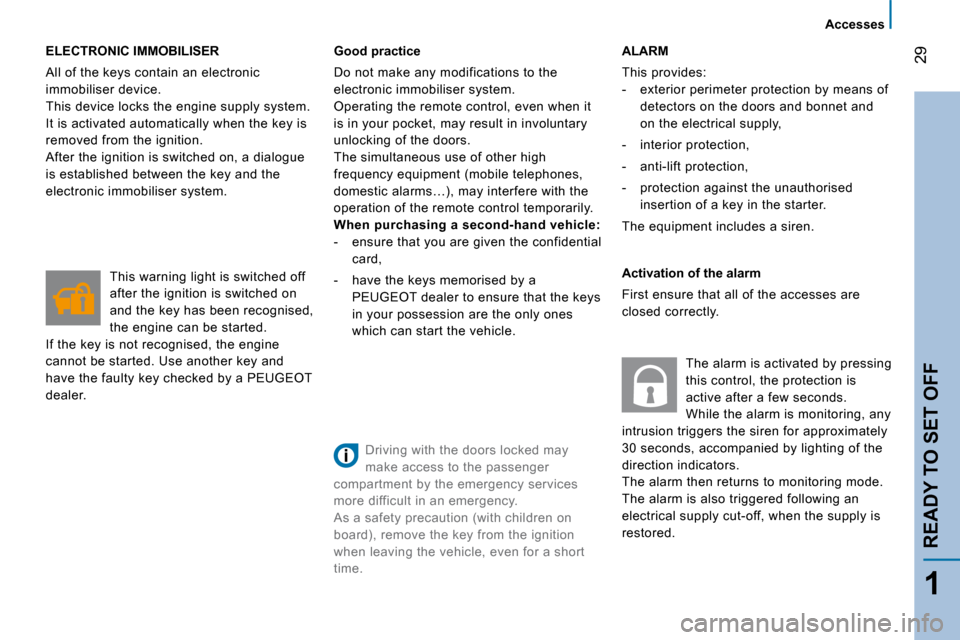
29
1
READY TO SET OFF
Accesses
ELECTRONIC IMMOBILISER
All of the keys contain an electronic
immobiliser device.
This device locks the engine supply system.
It is activated automatically when the key is
removed from the ignition.
After the ignition is switched on, a dialogue
is established between the key and the
electronic immobiliser system. This warning light is switched off
after the ignition is switched on
and the key has been recognised,
the engine can be started.
If the key is not recognised, the engine
cannot be started. Use another key and
have the faulty key checked by a PEUGEOT
dealer .
Good practice
Do not make any modifications to the
electronic immobiliser system.
Operating the remote control, even when it
is in your pocket, may result in involuntary
unlocking of the doors.
The simultaneous use of other high
frequency equipment (mobile telephones,
domestic alarms…), may interfere with the
operation of the remote control temporarily.
When purchasing a second-hand vehicle:
- ensure that you are given the confidential card,
- have the keys memorised by a PEUGEOT dealer to ensure that the keys
in your possession are the only ones
which can start the vehicle.
Driving with the doors locked may
make access to the passenger
compartment by the emergency services
more difficult in an emergency.
As a safety precaution (with children on
board), remove the key from the ignition
when leaving the vehicle, even for a short
time.
ALARM
This provides:
- exterior perimeter protection by means of detectors on the doors and bonnet and
on the electrical supply,
- interior protection,
- anti-lift protection,
- protection against the unauthorised insertion of a key in the starter.
The equipment includes a siren.
Activation of the alarm
First ensure that all of the accesses are
closed correctly.
The alarm is activated by pressing
this control, the protection is
active after a few seconds.
While the alarm is monitoring, any
intrusion triggers the siren for approximately
30 seconds, accompanied by lighting of the
direction indicators.
The alarm then returns to monitoring mode.
The alarm is also triggered following an
electrical supply cut-off, when the supply is
restored.
Page 33 of 131
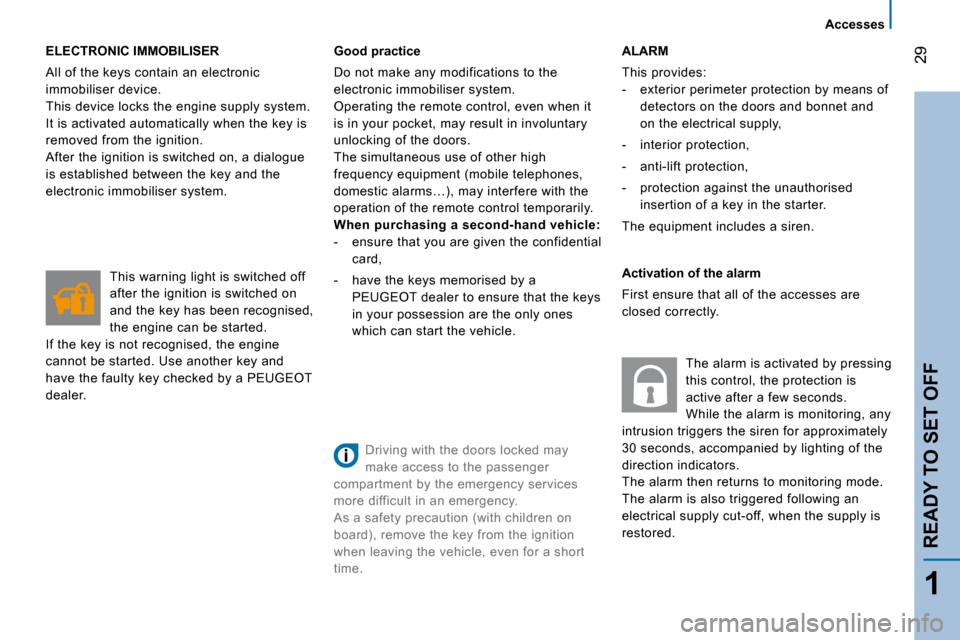
29
1
READY TO SET OFF
Accesses
ELECTRONIC IMMOBILISER
All of the keys contain an electronic
immobiliser device.
This device locks the engine supply system.
It is activated automatically when the key is
removed from the ignition.
After the ignition is switched on, a dialogue
is established between the key and the
electronic immobiliser system. This warning light is switched off
after the ignition is switched on
and the key has been recognised,
the engine can be started.
If the key is not recognised, the engine
cannot be started. Use another key and
have the faulty key checked by a PEUGEOT
dealer .
Good practice
Do not make any modifications to the
electronic immobiliser system.
Operating the remote control, even when it
is in your pocket, may result in involuntary
unlocking of the doors.
The simultaneous use of other high
frequency equipment (mobile telephones,
domestic alarms…), may interfere with the
operation of the remote control temporarily.
When purchasing a second-hand vehicle:
- ensure that you are given the confidential card,
- have the keys memorised by a PEUGEOT dealer to ensure that the keys
in your possession are the only ones
which can start the vehicle.
Driving with the doors locked may
make access to the passenger
compartment by the emergency services
more difficult in an emergency.
As a safety precaution (with children on
board), remove the key from the ignition
when leaving the vehicle, even for a short
time.
ALARM
This provides:
- exterior perimeter protection by means of detectors on the doors and bonnet and
on the electrical supply,
- interior protection,
- anti-lift protection,
- protection against the unauthorised insertion of a key in the starter.
The equipment includes a siren.
Activation of the alarm
First ensure that all of the accesses are
closed correctly.
The alarm is activated by pressing
this control, the protection is
active after a few seconds.
While the alarm is monitoring, any
intrusion triggers the siren for approximately
30 seconds, accompanied by lighting of the
direction indicators.
The alarm then returns to monitoring mode.
The alarm is also triggered following an
electrical supply cut-off, when the supply is
restored.
Page 114 of 131

104
Changing a bulb
Front lights
Open the bonnet. To access the bulbs, reach
behind the headlamp unit.
Remove the protective covers to gain
access to the bulbs.
Carry out the operations in reverse order to
refit each bulb.
CHANGING A BULB
T ypes of bulb
Various types of bulb are installed on your
vehicle. To remove them:
1. Type A
Entirely glass bulb: pull gently as it is fitted by pressure.
2. Type B
Bayonet bulb: press on the bulb then turn it anticlockwise.
3. Type C
Cylindrical bulb: move aside the contacts.
4. Type D - E
Halogen bulb: release the retaining spring from its housing.
Page 120 of 131

109
7
TROUBLESHOOTING
Changing a fuse
CHANGING A FUSE
The two fuse boxes are placed on the fascia
panel on the driver ’s side and under the
bonnet. PEUGEOT will not accept responsibility
for the cost incurred in repairing your
vehicle or for rectifying the malfunctions
resulting from the installation of accessories
not supplied and not recommended by the
PEUGEOT network and not installed in
accordance with its instructions, in particular
when the combined consumption of all of
the additional equipment connected exceeds
10 milliamperes.
Removing and fitting a fuse
Before changing a fuse, the cause of the
fault must be found and rectified. The fuse
numbers are indicated on the fuse box.
Always replace a faulty fuse with a fuse
of the same rating. - To gain access to the fascia panel
fuses, remove the 2 screws using the
screwdriver (located in the tool kit) and
tilt the box.
- To gain access to the fuses under the bonnet, remove the battery negative
cable and the front left light connector,
then unclip the fuse box cover.
Page 121 of 131

109
7
TROUBLESHOOTING
Changing a fuse
CHANGING A FUSE
The two fuse boxes are placed on the fascia
panel on the driver ’s side and under the
bonnet. PEUGEOT will not accept responsibility
for the cost incurred in repairing your
vehicle or for rectifying the malfunctions
resulting from the installation of accessories
not supplied and not recommended by the
PEUGEOT network and not installed in
accordance with its instructions, in particular
when the combined consumption of all of
the additional equipment connected exceeds
10 milliamperes.
Removing and fitting a fuse
Before changing a fuse, the cause of the
fault must be found and rectified. The fuse
numbers are indicated on the fuse box.
Always replace a faulty fuse with a fuse
of the same rating. - To gain access to the fascia panel
fuses, remove the 2 screws using the
screwdriver (located in the tool kit) and
tilt the box.
- To gain access to the fuses under the bonnet, remove the battery negative
cable and the front left light connector,
then unclip the fuse box cover.
Page 126 of 131
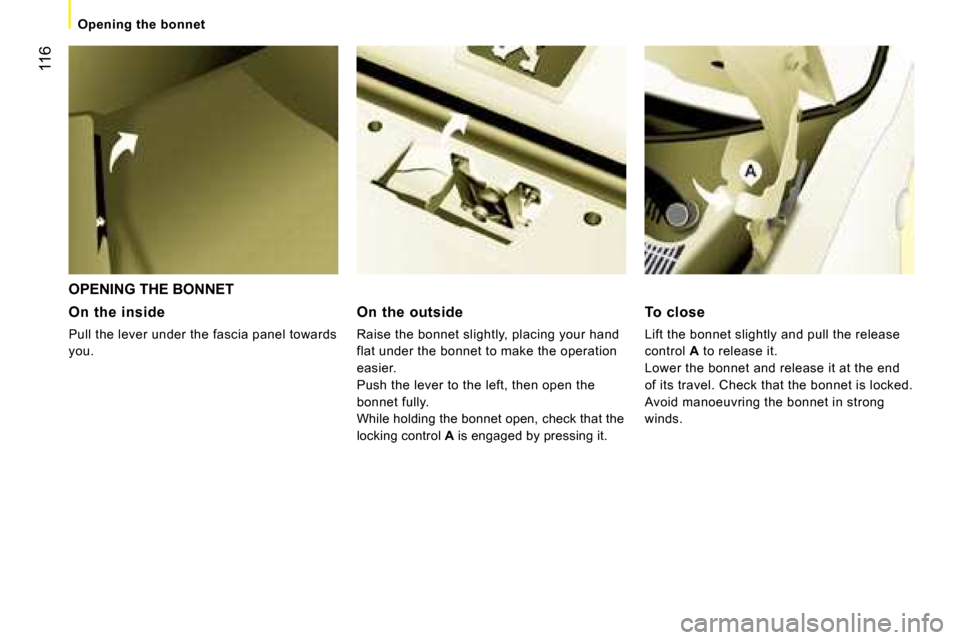
116
Opening the bonnet
OPENING THE BONNET
On the inside
Pull the lever under the fascia panel towards
you.
On the outside
Raise the bonnet slightly, placing your hand
flat under the bonnet to make the operation
easier.
Push the lever to the left, then open the
bonnet fully.
While holding the bonnet open, check that the
locking control A is engaged by pressing it.
To close
Lift the bonnet slightly and pull the release
control A to release it.
Lower the bonnet and release it at the end
of its travel. Check that the bonnet is locked.
Avoid manoeuvring the bonnet in strong
winds.
Page 127 of 131

117
7
TROUBLESHOOTING
Under the bonnet
Diesel engine
UNDER THE BONNET
4. Brake and clutch fluid reservoir.
5. Air filter.
6. Dipstick.
7. Engine oil filler cap.
8. Power steering fluid reservoir.
1. Windscreen wash reservoir.
2. Fuse box.
3. Engine coolant reservoir.